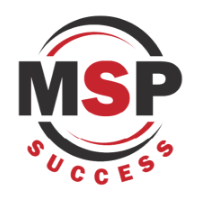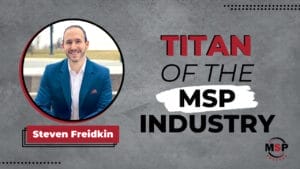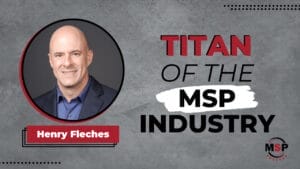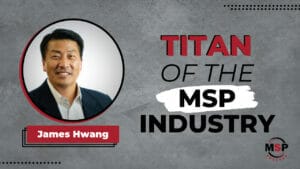James Hwang Credits 1Path’s Success To Its Elite Team, And Explains Why Having The Right People In Every Division Of Your Business—Not Just Operations And Engineering—Is Where Growth Begins
Note: This article is taken from a live interview and was edited for clarity and length.
When industry titan James Hwang joined 1Path as CEO four years ago, he developed a business plan with a single goal in mind: to simplify the company by returning to its core and focusing on what it excelled at – managed services. That meant divesting some of the company’s divisions that distracted from their goal, dropping company revenues from $160 million to $40 million. 1Path entrenched itself in managed services for the SMB market, growing during and after the pandemic. Today, the company exceeds $60 million in top-line revenue.
Robin Robins, CEO and founder of Technology Marketing Toolkit and MSP Success Magazine, talked to James about why chasing every dollar isn’t always the right strategy for a growing company, why having the right people in every division of a business is critical to success and how to unlock the power client relationships and a unified sales and marketing approach to drive titan-level growth.
Robin Robins: You’ve got an incredible story about 1Path going from $160 million to $60 million in revenue. But first, James, tell us a little bit about 1Path.
James Hwang: Four years ago, when I was brought into the company, we embarked on a strategy where we asked ourselves, “What is our core tendency? What is our focus?” I realized we had a great underlying managed services provider business, but it was hidden. The value was locked. In fact, to a certain degree, the value was diminishing because of all the other businesses around us.
For example, we had a federally cleared license, meaning we could go in and work at top-secret clearance areas. We had over 200 truck rolls, meaning our trucks across the country did things like fiber install and cable pulls. As an MSP, our core business is around managing other people’s technology but may not necessarily include digging trenches, doing fiber or cable runs. When I sat down with the stakeholders, I said, “We really need to simplify. We need to go back to our core – what we’re really good at, which is being a managed services provider to small and medium-sized businesses with a 100- to 1,000-employee base.” Ever since then, we’ve never looked back.
Robin: You’ve divested and focused down, so I’m curious: When a company is at $160 million in revenue, how much should you grow to know you’re getting it right?
James: Very good question. When we did our divestitures – and we had, by the way, four different divisions – we were doing things like video service processing in Malaysia. Our company should not be doing video service processing in Malaysia, so we shut that division down. We also consolidated other businesses, sold them off into the market, got very good pricing post-Covid and paid down the debt. As a private-equity-backed company, we have virtually zero debt.
Of course, our shareholders don’t like that because they want us to be levered and go out into the marketplace and acquire. We will do that eventually. But after all the divestitures, we were at about $40 to $42 million in top-line revenue. We grew even during and after Covid once we divested. We’re now exceeding that market, that $60 million mark. We’ve been growing faster than the industry.
Robin: Why do you think you’re able to grow so fast?
James: Number one, it’s our team. The people are the foundation. Number two, we’re beating the industry because of our focus, processes, leadership and all the team members who make up the day-to-day core values and the fundamental aspects of 1Path. Third, I think we’ve got an offering set focused on the right elements – not the technology aspect but the client experience aspect. That allows us to now price in premiums and other elements associated with that offering.
Robin: You had four different divisions; how did you pick which was the right lane?
James: You have to understand your customers, understand their voice. If you talk to one customer, they’ll say, “Hey, I need A, I need B, I need C.” Talk to another customer and they go, “I need A and D,” and talk to a third customer and so on. We talked to our customers and divided them into four different categories. Then, we talked to every single one of those top-tier category customers. What did they want? What did they need? What were their pain points? There are some outliers, of course, but when you get the meat of what the customer wants, then that’s what you offer. That’s what we did, and I’m proud of our team for doing so because it’s allowed us to have this success.
Robin: How many customers did you have at your peak, at $160 million?
James: At our peak we had over 1,500 customers. Of those, the 80/20 rule applies. Our top 150 to 250 customers – just short of our top 20% – encompasses about 73% of our revenue. They were speaking and we were listening for the first time.
Robin: When you decided to talk to your clients, how did you meet with everyone? Was it a dedicated meeting? Talk to me about that process.
James: There are three takeaways here. Most of the MSP members today, when we say, “Did you talk to that client?” they say, “Sure, we talk to them every quarter in a client briefing or QBR” or whatever the schedule of choice that you have. That’s very important. You should. Number one for our tactical teams is to have a way to connect with the client.
Number two is, have you broken bread and started a relationship with the top 10, 20 or 30 clients? At 1Path, we instituted our executive sponsorship program. Even our HR and CFO are married with the client to get to know them and build a relationship. When we break bread, I get to know you. That adage “People do business with people” proves itself when you are in front of those clients building a relationship.
The third aspect of this is to build a peer group network. We have a lot of clients who are in the healthcare industry, specifically the senior-living environment. We get those senior-living people and put together dinners, get together at trade shows or get with one another just to say what are some of the best practices – not to eavesdrop or share competitive intel – but just to say, “How do we help one another as peer groups and what are you seeing and what am I seeing?” When you do this at the customer level, and they can all leave with one nugget or one best practice, you just provided value.
Robin: Some CEOs tend to be more technical-minded and introverted, which I am as well, so they delegate QBs to sales calls, but what I’m hearing from you is the importance of spending time with customers to understand them better in a setting that’s not just a tactical type of meeting.
James: Right. You know, there are so many introverts on our team. I get it. But look on the other side, at the client. They’re probably introverts too. Yes, you’ll come across extroverts here and there, of course. But the sheer fact is you’ll find commonality with one another regardless of the business model. We happen to be in MSP services that we’re rendering to you, but I want to get to know you as a person, both personally and professionally.
Open yourself up to be vulnerable too. That’s how you make friends. When we can do the basic core things, we start connecting. It’s so hard to fire a person you know, but it’s so easy to fire a person who’s agent one, two or three behind a desk or a phone.
Robin: You said one of your focuses is having the right team. Do you have a secret sauce to finding or developing those people?
James: I don’t know if there’s a secret sauce for that. But we start with our core values foundation. When we go through our interviews, we don’t start with operational or sales questions. We start with core values questions. We have a little mantra that goes, “What do you eat? IEAT,” or “Integrity, Excellence, Accountability and Teamwork.” We have scenarios that are brought into each one of those core values as a question. We say, “How would you go about doing this? How would you handle a situation like this? Would you tell the boss?” There’s no right or wrong answer; it’s just a profile. It helps us understand if this person is going to culturally fit and can we invest into them over time? We really take time in going through this process. I know everyone will say, in a competitive environment, we will lose them. I get it. But do you really want to hire the wrong person? Or do you want to take the time and ensure you’ve got the right person for the next five, 10, 15 years?
The second thing is that I don’t think there’s a perfect player who’s out there. I’m not a perfect player. I’ve got to grow and educate myself. The question is, do they have the DNA to say, “I want to be invested into, I want to learn, to grow, to help everyone win together”? Then, you go into kind of the skill set and competency.
Robin: Once you’ve found the right person, do you have any advice on keeping them in this short labor market we’re in right now?
James: We’re very proud of the fact that we have employees who are over 20 years in tenure at 1Path. The first sheer fact is how do we reinvest and keep investing in every single person?
You also need to think about rotation. Just because you’re a technical person today doesn’t mean you can’t learn to be a salesperson and follow that process. All the way up to the highest levels of senior-level executives, I’ve invested in a person to go from operations to sales. You go, how in the world would you do that? If you think about what an operations person does in the MSP space, they know the client, the pain points, disruptions and issues that arise. Like every good salesperson, if you can look at an opportunity where things aren’t going right and ask, “How do you fix it?” that becomes an opportunity for future sales, revenue and relationship-building blocks.
Some of those who are operators today might get client engagement. Some client engagement may go back into customer service, or customer service may go into sales. I firmly that believe the more we can relate to one another within our workforce environment, the better we become. I know that’s a long game.
Robin: Is there a short game for building a strong team?
James: I think the short game for everyone here is that those entrepreneurs who are very operationally inclined – and I see so many of them, they’re great – but you must value sales and marketing just as great as those operators and engineering. I’ve now done 20 M&As going through this process of three different companies and platforms. Right off the bat, I could see some owners who value one business segment more than the other. I would say your front of the house, your back of the house, and your east and west sides are just as important, so why wouldn’t you put the emphasis on making sure every executive gets to know what our offering set is? What’s our pricing? What do our customers look like? What are our customers’ pain points? Why don’t they get involved?
Have those conversations as an executive sponsor. Once we can do that, the leadership then becomes up-leveled. When the leadership becomes up-leveled, then you’re going to demand everyone else be up-leveled. Now you’re going to start hiring up-leveled. Don’t settle for mediocrity, even if it means losing that candidate, especially in this supply-shortened environment.
Robin: All of us have had bad hires. Here, we do a debrief after a good – and especially a bad – hire where we talk about what we did wrong. What are we doing to improve next time? What’s your approach to handling a “bad” hire?
James: As leaders, owners and entrepreneurs, you have to have those crucial conversations. But #2 is we have this issue of, well, I’ve got a partner, I’ve got a friend, and I hired them because I know they’re a friend or we started this business together. Suddenly, we get to the point where we’ve hit this ceiling. One partner wants to go in a different direction, and the other wants to stay the same or whatever it may be. I always say that what got us here will probably not get us there. For the most part, what I’ve seen – and we’ve done this ourselves, we’ve hired friends, people we’ve known – is once they got to a certain level of capacity and capability, we felt we owed it to them to stay there. We forget to have those crucial conversations.
Just as much as hiring the right resource, you’ve also got to let the wrong resource go, and that allows you to unlock that next level of success. We had to do that inside of our MSP business. After all the divestitures, we said, “We’re ready for growth; we’re prepared to go in a different direction.” We had some leaders who may not have been aligned with that. And we said, look, we heard the customer. We also are building this plane together. We’re either in it together, or we’re not together. If there are one or two that aren’t, we need to intervene, have those conversations and hire the right resources to backfill. That’s exactly what we did.
Robin: Similar to hiring the right fit for your team, sales and marketing is going after the customers you want. Would you agree with that?
James: Sales and marketing is a professional organization that needs to live, breathe and be nurtured as much as operations and engineering. When I walk into an M&A discussion with a 100-person organization, there is usually only a six-person sales and marketing organization. The function hasn’t been nurtured. There’s no automation. There’s no visibility. There’s no scoring. There’s no approach. If you take just a quarter of what our engineering teams could do in operations and professionalize the sales and marketing approach, I am telling you, our industry’s total potential enterprise value should be in the trillions, but we haven’t unlocked that potential yet.
There are great MSPs and great entrepreneurs who know how to sell and market and who understand omnichannel. And then others are just “me too” players, saying, “I’ll hire one or two out of necessity.” Sales is a living, breathing organization, just like operations, finances and other organizations. You’ve got to nurture it. You’ve got to have a design for it, and then you’ve got to see it get to that next level – and set that expectation.
Robin: All entrepreneurs have strengths and weaknesses, which is why you’ve got to have a good team, because you’ll never be great at everything. When you get that A-team together, that’s when the magic happens. Do you agree?
James: Absolutely. There’s the adage that sales and marketing are contesting one another, but our chief revenue officer, Armon, has done a really great job of saying, “No, we’re working as a team.” In fact, he demanded that sales and marketing report into one CRO umbrella, and that’s what we did initially. It was two separate pillars like everyone else, and we combined that effort, our lead generation, channel, direct marketing and referral focus, and ultimately our indirect focus – all those came into that lead nurturing and marketing, working with one another.
I know many MSPs may not be at the stage where they can have a dedicated sales or dedicated account management team, but we’re fortunate enough to be in a situation where we bifurcated that.
Robin: What does your sales and marketing process look like today?
James: There’s a video on YouTube that breaks down the US Women’s Track and Field and how their four-by-four relay team passes the baton. They showed that there’s a symbiotic way to hand off a baton; there’s this world-class way, and there’s the other way. The world-class way is this: present, handoff, and the other party goes, “I got it, we’re together, now I’m running with it.” The “So what?’” of this is that there’s a critical stage where you must meet together instead of throwing it over the proverbial fence. Present. Meet. Tell them you got it.
That’s the teamwork process we’ve got to look at from marketing to sales to onboarding to the actual customer-journey side of the house and back to operations again, and so on. That’s what we’re trying to coach and live through our values within our company. It is so important and it’s why we can achieve some of the revenue increases and customer satisfaction we’re receiving today.
Robin: If a smaller MSP is watching this and wants to get to $6 million or $60 million, what advice would you give them?
James: If there’s one takeaway that I have, it starts with our people, especially the leadership. Then, be incredibly focused on your process. If you don’t have a five-year plan today, create one. This is when you get to say, “Hey, pie in the sky, I want to be at $100 million.” Create that plan. Now take that five years and then say, at the halfway point, “Where should I be?” From that halfway point, take it down into year two, year one. And from that year one, take it down to the quarter and the month. Visualize that process and say, “What do I need to sell? What do I need to retain? What do I need to grow, and who do I need to exit?” And I’m not talking about people necessarily, but that has some emphasis. I’m also talking about customers because there are customers you took that probably shouldn’t be around, and as you grow, you need to say no.
As you go through that people process, set up that vision, have those checkpoints and start looking up, you’ll be surprised where you’re at. Everyone’s talking about M&A and doing all the other things. Those opportunities will come. You make your luck; you’ll create your M&A opportunities if you focus on the people and the process you’re going through. Then you’ve got to balance the process, both sales and marketing, as well as operations, engineering and back office.







